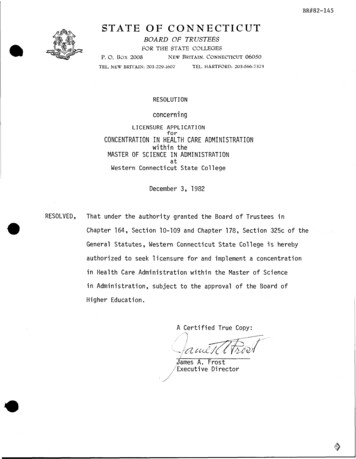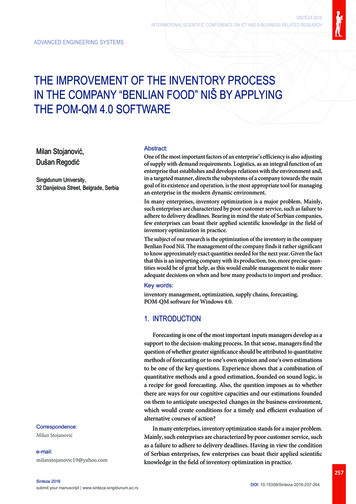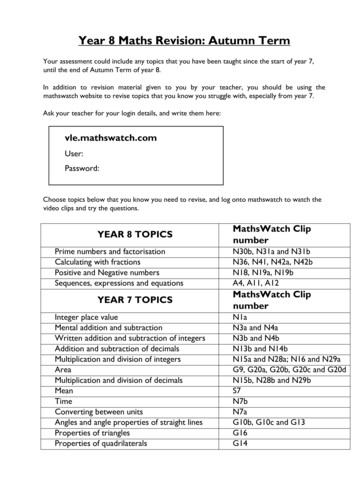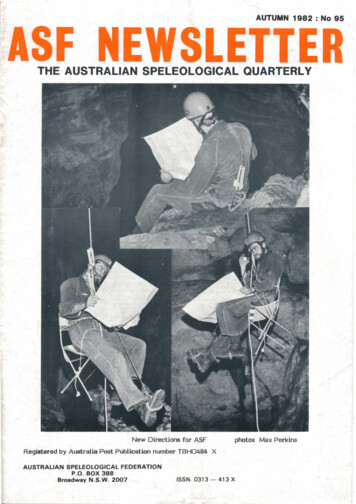
Transcription
AUTUMN 1982 : No 95ASF NEWSL TTERTHE AUSTRALIAN SPELEOLOGICAL QUARTERLYNew Directions for ASFphotos Max PerkinsRegistered by Australia Post Publication number TBH0484 XAUSTRALIAN SPELEOLOGICAL FEDERATIONP.O . BOX 388Broadway N.S.W. 2007ISSN. 0313 -413 X
EXECUTIVE OFFICERS & MEMBER SOCIETIESPlease write direct to the Officer concerned as the P.O. Box is only a clearing addressTrusteesJ N JENNINGSBPMOORE4 Hobbs St, O'Connor ACT 260 116 Lambert St, Lyneham ACT 2603EXECUTIVE COMMITTEE MEMBERS:PresidentVice PresidentsSecretaryAssistant SecretaryTreasurerKEN LANCEPO Box 2336 South HeadlandJOHN DUNKLEYJULIE MOOREMILES PIERCE3 Stops Place, Chifley ACT 260633 Bolinda Rd North Balwyn Vic 310442 Victoria Cres Mont Albert Vic 3127CATHIE ROTHERYTERRY O'LEARYLLOYOMILLWA 672278a Balaclava Rd Eastwood NSW 212230/26a Wolli Creek Rd Banksia NSW 2216162 Buckley St Essendon Vic 3040091 72 2153 w091 72 2673 h06281066403857 712903 89831902858352402 59440303337 1853CONVENORS OF COMMISSIONS:Administration"Australian Speleology"BibliographyBiologicalCave SafetyCave Tourism & ManagementConservationInternational RelationsLibraryLongest & Deepest CavesNewsletter EditorNewsletter - ManagerMembershipSpeleo HandbookSurvey StandardsM42 Victoria Cres Mont Albert VicMILES PIERCEANDREW PAVEY45 Arcadia Rd Glebe NSWPO Box 269 Sandy Bay TasGREGORY MIDDLETONPO Box 36 Carlton South VicELERY HAMIL TON-SMITHJOHN WEBB50 Delbridge St North Fitzroy VicPO Box 36 Carlton South VicELERY HAMIL TON-SMITHROY SKINNER12 Baker St Lenah Valley TasADRIAN DAVEYPO Box 668 Grafton NSW3 Stops Place, Chifley ACTJOHN DUNKLEYPO Box 36 Carlton South VicELERY HAMILTON-SMITHANDREW SPATEPO Box 16 Talbingo NSWROSS ELLIS11 Arkana St Telopea NSWPO Box 230 Milsons Point NSWROMAN LICHACZ48 Gwyder St Greystanes NSWIAN MANNPETER DYKESPO Box 1338 Orange NSWPETER G MATTHEWS66 Frogmore Crescent Park Orchards VicBRUCE WELCH21 Thompson St Marrickville 72061214526003114220403 89831902660753603489938606644527906281 066406949521902630538402 80194302631 4321063627274038761467025699928CONVENORS OF AD HOC COMMITTEES:Beginners ManualCave DocumentationIncorporationMembershipPublic RelationsNibiconCave ConvictFourkarstIUS Convention 1989PHILIP TOOMERPETER G MATTHEWSJOHN DUNKLEYPETER DYKESPETER B MATTHEWSANDREW PAVEYPHILIP MACKEYGRAHAM PILKINGTONPHILIP TOOMERPO Box 230 Milsons Point NSW66 Frogmore Crescent Park Orchards Vic3 Stops Place, Chifley ACTPO Box 1336 Orange NSW81 Cole St Downer ACT45 Arcadia Rd Glebe NSW3 Nowra Court Frankston Vic66 Eyre Cres Valley View SAPO Box 230 Milsons Point 9290432PO Box 230 Milsons Point NSW 206102929043202929043203876 1487062610664063627274062489746026607536CONVENORS OF STATE SPELEOLOGICAL COUNCILS:NSW Speleological CouncilPHILIP TOOMERCOMMITTEE MEMBERS:VOTING MEMBERSACT:CANBERRA SPELEOLOGICAL SOCIETYCAPITAL TERRITORY CAVING GROUPNATIONAL UNIVERSITY CAVING CLUB18 Arabana St Aranda ACT 2614PO Box 638 Woden ACT 2606c/- Sports Union, Australian National University ACT 2600NSW:BAPTIST CAVING ASSOCIATIONPO Box 140 Greenacre NSWPO Box 37 Glenbrook NSWBLUE MOUNTAINS SPELEOLOGICAL CLUBHIGHLAND CAVING GROUPPO Box 154 Liverpool NSWILLAWARRA SPELEOLOGICAL SOCIETYPO Box 94 Unanderra NSWKEMPSEY SPELEOLOGICAL SOCIETY2 Albert St Kempsey NSWMACQUARIE UNIVERSITY CAVING GROUP c/- Sports Union, Macquarie University Nth Ryde NSWMETROPOLITAN SPELEOLOGICAL SOCIETYPO Box 2 Crows Nest NSWNSW INSTITUTE OF TECHNOLOGY SPELEO. SOC.c/- The Union, PO Box 123 Broadway NSWPO Box 752 Orange NSWORANGE SPELEOLOGICAL SOCIETYPO Box 198 Broadway NSWSYDNEY SPELEOLOGICAL SOCIETYBox 35 The Union Sydney University NSWSYDNEY UNIVERSITY SPELEOLOGICAL SOCIETYUNIOF NSW SPELEOLOGICAL SOCIETYBox 17 The Union UNSW Kensington NSWQUEENSLAND:CENTRAL QUEENSLAND SPELEOLOGICAL SOCIETYPO Box 538 Rockhampton QldUNI OF QUEENSLAND SPELEOLOGICAL SOCIETYThe Union, Uni of Q'land St Lucia QldSOUTH AUSTRALIA:CAVE EXPLORATION GROUP (Sth Australia) Inc.c/- SA Museum Nth Terrace Adelaide SATASMANIA:NORTHERN CAVERNEERSPO Box 315 Launceston TasSOUTHERN CAVING SOCIETYPO Box 121 Moonah TasTASMANIAN CAVERNEERING CLUBPO Box 416 Sandy Bay TasVICTORIA:VICTORIAN SPELEO ASSOCIATIONGPO Box 5425 CC Melbourne VicWESTERN AUSTRALIA:SPELEOLOGICAL RESEARCH GROUP WAPO Box 120 Nedlands WAWESTERN AUSTRALIA SPELEOLOGICAL GROUPPO Box 67 Nedlands 470040675000725070097005300160096009A oclat AVONDALE SPELEOLOGICAL SOCIETYCAMPELLTOWN CAVING & OUTDOOR GROUPCHILLAGOE CAVING CLUBHILLS SPELEOLOGY CLUBMOUNT ISA CAVING CLUBNORTH WEST WALKING CLUBROYAL AUSTRALIAN NAVY CAVING ASSOCIATIONNORTH QUEENSLAND SPELEOLOGICAL ASSOCIATIONPAPAU NEW GUINEA EXPLORATION GROUPAvondale College Cooranbong NSW 2265PO Box 281 Campbelltown NSW 25607 Martyn St Cairns Qld 4870PO Box 198 Baulkham Hills NSW 215376 Pelican St Mount Isa Qld 4825PO Box 107 Ulverstone TAS 7315c/- School of Chemistry Sydney Uni NSW 20061 Boden St Edge hill Qld 4870ct- M Pound PO Box 3824 Port Moresby PNGII(
DDDDDDASF NEWSLETTERDDDDDDAUTUMN 1982 : No 95TABLE OFEditorial ENTS . . . . No t e son the AS F . . . . . . . . . . . . . . . . . . , . . . . . . . . . . , . . . , . . " . . . . . . . . . . . . . , . . . . . . . . . .Conservation Column- Mullamullang in need of help?N Poulter- More Caves, Archaeology, Turmoiland Problems on the Franklin RiverK KiernanTharnpana Cave (N206) N Pou It e rSerendipity:A New Florentine Swallet S & R EberhardGuano . Down Under AllOver . Notices & News . I233-56-76-9910-1212EDITORIALThis edition of the A.S.F. Newsletter is notable in that it is thefirst time for many years that the editorial and managerialfunctions have been located in one city. The fact that thenewsletter has appeared in the past has been due to the hardwork of Rosie Shannon the outgoing editor, and Tony Culburgthe previous business manager. On behalf of all members I wouldlike to extend our thanks for keeping the newsletter runningdespite the tyranny of distance. Thanks should also go to JohnTaylor who has just resigned as A.S.F. Treasurer, a position hehas held for eleven years. The Federation has been fortunateindeed to have had such continuity in the management of itsfinances.The theme of this issue is "A New Direction for ASP', and thereare several reasons for this choice of theme. The newsletteritself has had a move and the editorial, managerial and backissue functions are now located in Sydney. We hope this willlead to better communications and alleviate some of the pastproblems, which were largely caused by distance.Communication, or rather the lack of it, was a major theme ofdiscussion at the ASF Committee Meeting held in Canberraearlier this year. (An appropriate city in which to discuss lackof communication!). the delegates who attended that meetingfelt that the ASF had lost its identity with the generalmembership. The average speleo-club member it was said,seemed to see the ASF as a mythical "THEM" rather than seeingit as an organisation of which they are an integral part. Thiswas put down to a lack of communication. It was suggested bysome of the more acidic critics that if the executive of the ASFand the convenors of the various Ad Hoc Committees do notreport on their activities,delegates can not give any informationto their clubs. Similarly, if the clubs do not send delegates toASF committee meetings or do not INSIST that their delegatesreport to their members, they still don't get information aboutthe activities of the ASF.The ASF is doing things, but the membership is not beinginformed.The Newsletter is going to keep you informed. Executivemembers such as the President and Convenors of some of theAd Hoc Committees, through the Newsletter, will be keepingyou up to date with reports of their activities. The President'scolumn will be a regular feature starting in the next issue andnews from the Ad Hoc Committees will be printed asinformation comes to hand. These reports will be concise andinformative, with the aim of keeping you up to date with whatyour Federation is doing.As well as providing more space for "Federation News" theNewsletter committee intends to start some new sections, whichit is hoped will increase interest in the newsletter. In this issueyou will notice we have a "Conservation Column" and a sectionentitled "Guano", The latter is largely a miscellaneous columnfor such things as funny stories, cartoons, recipies and any otherbits and pieces. Other columns we intend to introduce as regularfeatures are an "Equipment and Techniques Column" and a "20years ago" segment. We will also make use of good articles,from other publications, which deserve wide circulation.Finally, we need two things; firstly your support, as thisnewsletter is only as good as its contributors. If we don'treceive material from you, we cannot go to press. We are indesperate need of copy for the next issue so PLEASE put pen topaper! Secondly, we need constructive criticism. We are allnew to the job and comments on any aspect of newsletterproduction and content will be appreciated.Remember, the success of this newsletter is your responsibility,we just put it together.What sort of member are you ?Are you an active memberThe kind that would be missed?Or are you just contentedThat your name is on the list?Do you attend the meetingsAnd mingle with the flock?Or would you rather stay at homeAnd criticise and knock?Do you take an active partTo help the work along?Or do you feel you've done your partBy saying "I belong"Do you work on committeesTo make the group tick?Or leave the work to just a fewAnd talk about the clique?Please come to meetings oftenHelp out with hand and heartDon't be just a memberBut take an active part.Think it over ask yourselfThe question isn't long"Am I an active member Or do I just belong?"- AnonymousPublished by "Port Macquarie News"
ASF NEWSLETTER No. 95 (1982): 2No-rES ON THE ASFTwo thirds of the member societies of ASF were not present atthe Committee meeting. A quorum was only just present.ActionI.Clubs should establish a position of Environment Officer (ifone does not already exist) who could, with convenors of theappropriate ad hoc committees, help ASF have a muchmore widespread and co-ordinated voice in conservationissues.2.Consider the Aims of ASF. A motion was passed to doublethe number of Associate groups. The ASF at the momentdoes not reach enough cavers and we must increase our baseof support if we wish to remain a viable organisation.Individuals and clubs need to think about the questions ofindividual, group or other forms of membership; methods ofspreading our message and ways of getting ASF tasks done.A Report of the ASF Committee Meetingon 30 and 31 Jan 82TERR Y O'LEAR YThe annual ASF committee meeting was held in Canberra on theJanuary long week end. Many societies did not send delegates tothe meeting, so I have prepared the following brief notes aboutthe major items of interest.The new ASF Secretary is Cathie Rothery and Uoyd Mill is thenew Treasurer. Uoyd replaces John Taylor who has done anexcellent job for the last II years. I am the new assistantSecretary.As the ASF is to be incorporated in the ACT the need for aPublic Officer has arisen. Jim Reid, who lives in the ACT, hasbeen persuaded to fill this position.The Newsletter is now under new management, Roman Lichaczis the editor, and the new manager is Ian Mann. This means thatthe newsletter preparation and management is now centralisedin Sydney.The Membership Ad Hoc Committee has been reformed withPeter Dykes (HCG) as its new convenor. Other members areDarel! Warden (Hills Speleo. Club), Ben Nurse (SSS) and AndrewPavey (UNSWSS).It was proposed that the 1989 IUS conference be held inAustralia. Philip Toomer is contacting people known to beworking in this area. Philip is the convenor of an ad hoccommittee to investigate the feasibility of Australia hosting thisconference. I am sure he would appreciate any thoughts on thematter. I have been seconded to the ad hoc committee and feelsuch a conference is an excellent chance to advance speleology(and caving) in this country. Planning must begin now if we wishto convince the IUS that we can host the conference. Thedeadline is the 1985 IUS Conference.Various reports were given by ASF committee members andhighlights will be published in the ASF Newsletter. However,some points of interest are as follows.A cave in South Western Tasmania, which has become a majorarchaelogical site, will not be called Fraser Cave. It is againstASF and International Union of Speleology (IUS) policy, as wellas normal geographical nomenclatural practices, to name cavesafter living persons. The cave is on the lower Franklin Riverand under threat of being flooded.Editors Note: The amount of recent publicity given to the nameFraser Cave will, however, make this decision virtuallymeaningless!It was suggested that ASF revise its administration to helpimprove communication and hence its image. In line with thesesuggestions an ASF brochure is being prepared and thenewsletter's structure is being reviewed.There will be a Tourism and Managment Conference at LakesEntrance (in Victoria near Buchan) in 1983 (Autumn?).There are several ASF publications which should be used by clubsin conservation submissions. They are "Guide o SubmissionWriting", "Guidelines on Conservation" and "Bibliography".Conservation efforts are to be co-ordinated by EleryHamilton-Smith and the convenor of the Ad Hoc Committee onConservation. I feel they would appreciate every club having amember responsible for conservation and environmental issueswho could correspond with them and help where possible.Hills Speleology Club, who have been Associates for some time,applied for full membership of ASF. A postal vote is requiredsince 2/3 of ASF member societies must approve suchapplications (and prior notice must be given). The 11 ASF groupsrepresented at the committee meeting all agreed that HillsSpeleo. Club should be admitted as full members of ASF.RE-ORGANISA TION!We tried hard - but it seemed that every timewe were beginning to form into teams, wewould be re-organised. I was to learn later inlife that we tend to meet any new situation byre-organising and a wonderful method it can befor creating the illusion of progress ion.Petronius Arbiter, 210 B.C.Letters to the EditorArchaio/Fraser CaveNow here indeed is a vexatious situation. I find I must agreewith Kevin Keirnan and company in their motivations for namingcaves along the Gordon and Franklin rivers after incumbentpoliticians al though the contribution to the attainment of thedesired effect by this means seems a bit ineffectual now thatthe controversy over the area has reached such proportions as ithas. I doubt that the Prime Minister is really likely to beimpressed to the extent that it would influence any decisions hemight make to any notable degree. I hasten to add howeverthat my sympathies lie wholeheartedly with those who are tryingto save the Franklin and perhaps the balance is so delicatelypoised that any contribution is worthwhile.I must also agree with John Dunkley's lamentation that weshould not be saddled with the name Fraser Cave for ever.Albert Goede's claims to impartiality on the part of theTasmanian Nomenclature Board have a somewhat hollow ringwhen, as Kevin points out, one considers the decision on LakePedder (a name which I for one have never acknowledged inrespect to the larger version). But notwithstanding that theboard has made some unfortunate choices in the past, I feel Imust support Albert's assertation that impartiality andresistance to pressure from political or any other pressuregroups should be maintained in the decision making.I suggest that, as the board has accepted my proposed name, itwithhold from seeking ministerial approval and thereby fromofficial gazettal and we all go along with Fraser cave until thepresent furore has been settled one way or the other. If theconservation case triumphs the name can easily be changedlater, if not it won't matter anyway - except to a few intrepidcave divers.ARCHAEO - GR formerly and still sometimes speltARCHAIO - Ancient, primitive.(Oxford dictionary definition).ROY SKINNER31/12/81
ASF NEWSLETTER No. 95 (1982): 3Conservation ColumnMullamullang- In Need of Help?NORMAN POULTER - SRGWAMullamullang Cave (N37) is Australia's second longest cave, andin caving circles at least, is one, if not 'THE', most famous.First entered in 1964, negotiation of its 4.8km main passage isno easy task due to the cave's high humidity, seemingly endlesshigh rockpiles and the salinity of its many lakes. A lot ofpeople who visit the cave vow never to return but rarely forgetthe experience. Maybe it is because of the former sensation lamullang is starting to show the suffering it has received atthe hands of its visitors.Mullamullang was most likely the first cave in Australia to havea base camp established in it (Hill 1966). For the 1965-66Expedition, a camp was located at the 'Junction', 4km from theentrance. There 20 people, with surface support, spent sevendays to permit study of the cave without an ardious, daily,multi-hour trip from and to the surface.A legacy of the 1966 Expedition that remains in the cave todayis an 'emergency dump' at Camp One and a telephone line,which was lain so that the Camp could maintain contact with thesurface in order to co-ordinate supplies. In recent times this'dump' has been depleted to the extent that there is now onlyspent carbide, contained in a rusting dish two empty square tinsand three plastic bottles.My first experience with MullamuUang was during the 1972CEGSA Diving Expedition. The well planned organisation of thisexpedition fell short in relation to the underground camp itrequired in Mullamullang. Little thought had been given by themulti-society participants to the removal of human body waste(solids) from the cave, with the result that there were quite afew little sealed plastiC bags scattered throughout the caveduring the five day underground stay. A couple of mine wereamong them, a practice not repeated on later trips.It is also evident that the various deposits of carbide primarilyoriginate from - cavers, even though it can be argued thatcarbide and carbide lights are freely available from campingstores throughout Australia.With the introduction of the non-camping in caves policy, theremust be plenty of room in the rucksacks of individualMullamullang visitors to remove the remaining rubbish fromCamp One and even some of the dumped carbide from the mainpassage. Small cup-l ike scoops, burst-proof containers andperhaps a brush and pan would be all that is needed for this littlechore. Empty tins and plastic bottles are easy items to carryout of a cave.It is perhaps fortuitous that the forthcoming ASF Conference isto be held in Adelaide at the end of 1982. It should be a forgoneconclusion that an expedition to the Nullarbor will be planned.If this is the case, then a golden opportunity presents itself torehabilitate Mullamullang, organised as part of the Conferencefield trips.During the Goede/Jennings Expedition, Adrian Davey wastheorising that restoration of the damaged sections of theCoffee and Cream may be possible with the aid of old fashionflour sifters. It may be possible to duplicate the texture of thedecoration. A discreet sign inside the entrance to the regionadvising cavers and non-cavers alike as to what is expected ofthem was suggested also.The amount of rubbish remaining at Camp One is not great. Therubbish could be removed by a small party of people in one trip.As mentioned previously, all that would be needed to remove thecarbide is a small cup-like scoop and a strong container.Removal of small amounts of dumped carbide from the mainpassage would be a bit more difficult, but feasible. Severalkilometres of the now useless telephone line presents its ownlogistic problem of how much of it can be pushed into a givenrucksack.In order to prevent further abuse by carbide users, it may be anidea to find out if it is possible to attach labels to carbidecontainers sold through retail outlets describing the correctmethod of carbide disposal. A 'DON'T DUMP CARBIDE' sign inMullamullar)g might prove useful.The situation in Mullamullang is not serious - yet. Let's get inbefore it does.REFERENCESAn unexpected visit to Mullamullang during the 1981Goede/Jennings Nullabor Expedition allowed a more enlightenedappraisal of the cave to be made.Hill A. L. 1966 Mullamullang Cave Expeditions 1966Occasional paper 114 CEGSAIt was found that:Poulter N. 19811.2.A trail of empty soft drink cans had been established in theearly stages of the cave - presumably heading for theEaster Extension.Spent carbide had been dumped indiscriminately throughoutthe main passage.3.The telephone lines were broken in numerous places makingits future use negligible.4.The 'dump' at Camp One consisted of spent carbide, emptycontainers and galvanised roofing nails - to hold up theceiling of the Dome perhaps5.Several deliberate hand and foot prints had been carefuUypressed into the Coffee and Cream section of the EasterExtension, possibly to act as scale for photographs or just tosee what the texture of the decoration was like. Some ofthe prints were that of a small child.During visits to the cave, over a period of t ree days ,severalkilograms of nails, containers of spent carbide, the drink cantrail and a quantity of telephone line were removed from variousparts of the cave.It is evident that there is an increasing number of non-caversvisiting Mullamullang. This is indicated by talks with staff atnearby Madura Roadhouse, the drink can trail and more thanlikely, the hand and foot prints in the Easter Extension.SRGWA (in) Down Under All Over.Newsletter 1192.ASFMORE CAVES, ARCHAEOLOGY, TURMOIL ANDPROBLEMS ON THE FRANKLIN RIVERKEVIN KIERNANThe discovery of further archaeological sites in the threatenedFranklin River Valley has shown that remote karst area to beone of the great archaeological areas of the world. Finds weremade both in known caves and in new caves discovered duringFebruary - March 1982. None of the finds equal the richness ofthose found in Fraser Cave, but they compliment them. TheFranklin River Valley has become the richest archaeological areain Australia - equal in significance to the classic prehistoricvalleys of Fra ce in the unravelling of the history of humankind.The Emerging PictureWithin the Franklin River Valley, a controversial part ofTasmania'S South-West wilderness, lies evidence of the lonliestoutpost of humanity in Prehistory. This was man's mostsoutherly outpost during the last Glacial Period. For man washere 10,000 years before he reached South (and probably North)America. The cave sites beside the Frankl in River rec.ord hisemergence from Asia and the trek southwards to a subantarcticpeninsula, where he was not to follow the path of agriculturepursued by his European contemporaries.
ASF NEWSLETTER No. 95 (1982): 4Amid the rigours of an ice age, limestone caves assumed animportance to man in Tasmania far surpassing that which theyheld on mainland Australia. Cut off on an island by the risingpost glacial seas, which drowned the land bridge by which he hadgained access to the Tasmanian peninsula and constantly drivenback, as a rising sea level drowned his coastal dwelling places,man was forced from the western karsts by the spread ofincreasingly dense vegetation. The sunny cave entrances aroundwhich this remarkable people had warmed their bodies as theybutchered wallabies and flaked stone tools, in a manner sosimilar to their European counterparts, now fell silent and werelost in the shadows of the dripping forests. The relicts werelater eroded by a surfeit of running water.Ten thousand years after this departure from the caves theforestsbegantocontract.Perhaps sometentativere-exploration commenced in the late Holocene. The FranklinHiver Valley was entered by escaping convicts and earlysurveyors who found the environment equally difficult. Tribalmemory of caves was gone, and no artefacts were added tothose which had been left behind in the ice age strong holds.Re-exploration by the indigenous people was tragicallyterminated by the Violence, greed, and insensitivity ofagricultural invaders from another hemisphere. Their revulsionat seeing their own recent past being acted out in this distantland caused them to eliminate the actors upon the stage theyover-ran.Politics Running AmokMuch has transpired since my last contribution to thisnewsletter. On 12 December 1981, all Tasmanian electors votedin a referendum on a proposal which would flood the FranklinRiver Valley. Their choice was between the on-below-Franklin proposal; favoured by the Hydro ElectricCommission, State Opposition and rnulti-national industrialists.The state Labor premier Doug Lowe assured listeners to thenational current affairs radio prograrnme "AM" that Tasmanianswould be able to vote for the option of no dams at all. He wasforced by his party to rescind thut undertaking. The reason? A"no dams"result was untenable to the government. The joke?Dernocracy. The choice? Between losing an arm or losing aleg. The result? 33% of Tasmanian electors voted informallyby writing "No Dams" across their voting paper.Never before in Australian history had such a thing happened.Only seven percent (7%) voted for the Gordon-above-Olga itself a vote against flooding the Franklin. Thirteen percent(13 %) voted informally without writing "no darns" across theirvoting paper. Forty seven percent (47%) voted to flood theFranklin.Immediately before the referendum a savage political axing sawDoug Lowe ousted as Premier by Harry Holgate. Lowe resignedfrom the government and called for Federal intervention intothe factionalism occurring in the party he had served for somany years. This came only a day after moderate state LiberalParty leader Geoff PearsaJl was ousted by staunch damsupporter Robin Gray. Government whip Mary Willey alsoresigned to join Lowe and Australian Democrat Dr NormanSanders on the cross benches. From there the staunch anti damsthreesome held the balance of power.Holgate was left at the helm of a minority government whichannounced a new policy of support for flooding the Franklin.The stat Liberal Party announced it would pass the damlegislation before seeking to topple the government. Faced witha troublesome cross bench, and attempting to play for time,Holgate successfully sought a three month's prorogual ofParliament. In consequence the Franklin Dam legislation couldnot be enacted in time to permit construction to commenceduring the 1981-82 summer and gave Fraser Cave another year.Tasmania is a claimant state. If the scheme is approved much ofthe finance is likely to come from the Federal Government - allAustralian taxpayers will pay to destroy Fraser Cave. Themagnitude of this impost is causing increasing concern outsideTasmania, as it is to those Tasmanians who realise that they arealready faced with debts on HEC borrowings of 700 million, or 1,600 per person. The annual interest bill is 50 million.Fi tty percent of Tasmania's Joan funds are spent on dams andpower stations, while hospitals and roads suffer for lack offinance. In 1981 Prime Minister Malcolm Fraser, after whomFraser cave was named, conceded in writing that the theAustralian Government had an obligation to protect theSouth-West. Only a few months later he was claiming that theissue was one for the State Government.As the South-West is listed on the register of the NationalEstate there are indeed legislative obligations on Fraser'sFederal Liberal Government, however embarassing that might beto the pro-dams branch of his party in Tasmania. No doubt henoted that in March 1982 11 % of the mainland electorate ofLowe scrawled "No Dams" across their ballot papers for theby-election to fill the seat left vacant by the retirement offormer Liberal Prime Minister Sir William McMahon.Back in Tasmania an attempted public relations onslaught bythe Holgate government announced the appointment oftelevision naturalist Harry Butler as its consultant onenvironmental matters. Butler, who has made his reputationfrom television and his money from mining companies has oftenbeen criticised by conservationists. Professor John Mulvaney ofthe Department of Prehistory at the Australian NationalUniversity was one of the many who condemed the appointmentand Butler's "dig it up quick" approach to Fraser Cave.Mulvaney specifically cited Butler's lack of archaeolocicalcompetence, evidenced by the bulldozing of rock engravingsdismissed by him at a development site in Western Australia.The Select committee of enquiry set up by the Australian Senatevisited Fraser Cave by helicopter. Its importance was explainedto them by archaeologist Rhys Jones and also by ProfessorMulvaney, who had previously described the site as having thegreatest potential of any he had encountered in Australia. TheAustralian Heritage Commission, of which Mulvaney was actingchairman, unanimously condenmed the power scheme. Twotelevision crews also visited the cave, together with theTasmanian Parks Minister Dick Adams, a man who voted incabinet, on several occasions, to destroy Fraser Cave. Adamswas subsequently carpetted by Premier Holgate after anabysmal performance in a cave mouth interview.The Tasmanian Wilderness Society, whose current Director DrBob Brown was a member of the party which discovered therelicts in Fraser Cave, has
3 Stops Place, Chifley ACT 2606 33 Bolinda Rd North Balwyn Vic 3104 42 Victoria Cres Mont Albert Vic 3127 78a Balaclava Rd Eastwood NSW 2122 30/26a Wolli Creek Rd Banksia NSW 2216 162 Buckley St Essendon Vic 3040 CONVENORS OF COMMISSIONS: Administration "Australian Speleology" Bibliography Biological Cave Safety


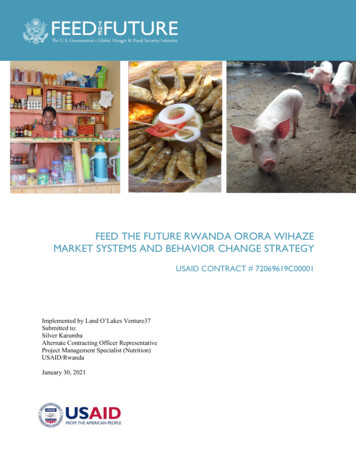
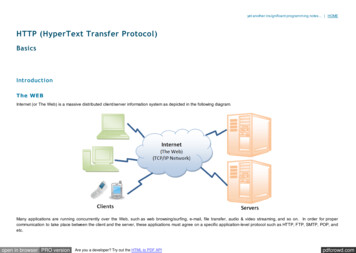

![4535&(* '3.&803, '03 %&.* 41 & ] - University of Virginia](/img/39/uvaacademicspaceframeworkplan.jpg)
